
Every week, we'll be sitting down with one of our gallery artists to discuss their work, process, inspiration, and stories. This week we're speaking with Diane Ayott.

"Recurrent Dreams"
Upon first glance, Diane Ayott's vibrant, hypnotic works are an intriguing exploration of color and pattern. When viewed up close, they become even more transfixing as details of the marks are revealed. Ayott plays with technique and texture, and often incorporates mixed media materials that are typically not evident from afar. What may have initially seemed mathematical in process is now understood to be motivated by intuition. Ayott spoke with us from her studio in Massachusetts to discuss how she balances this relationship, her insatiable love of images, and the importance of keeping a sketchbook.
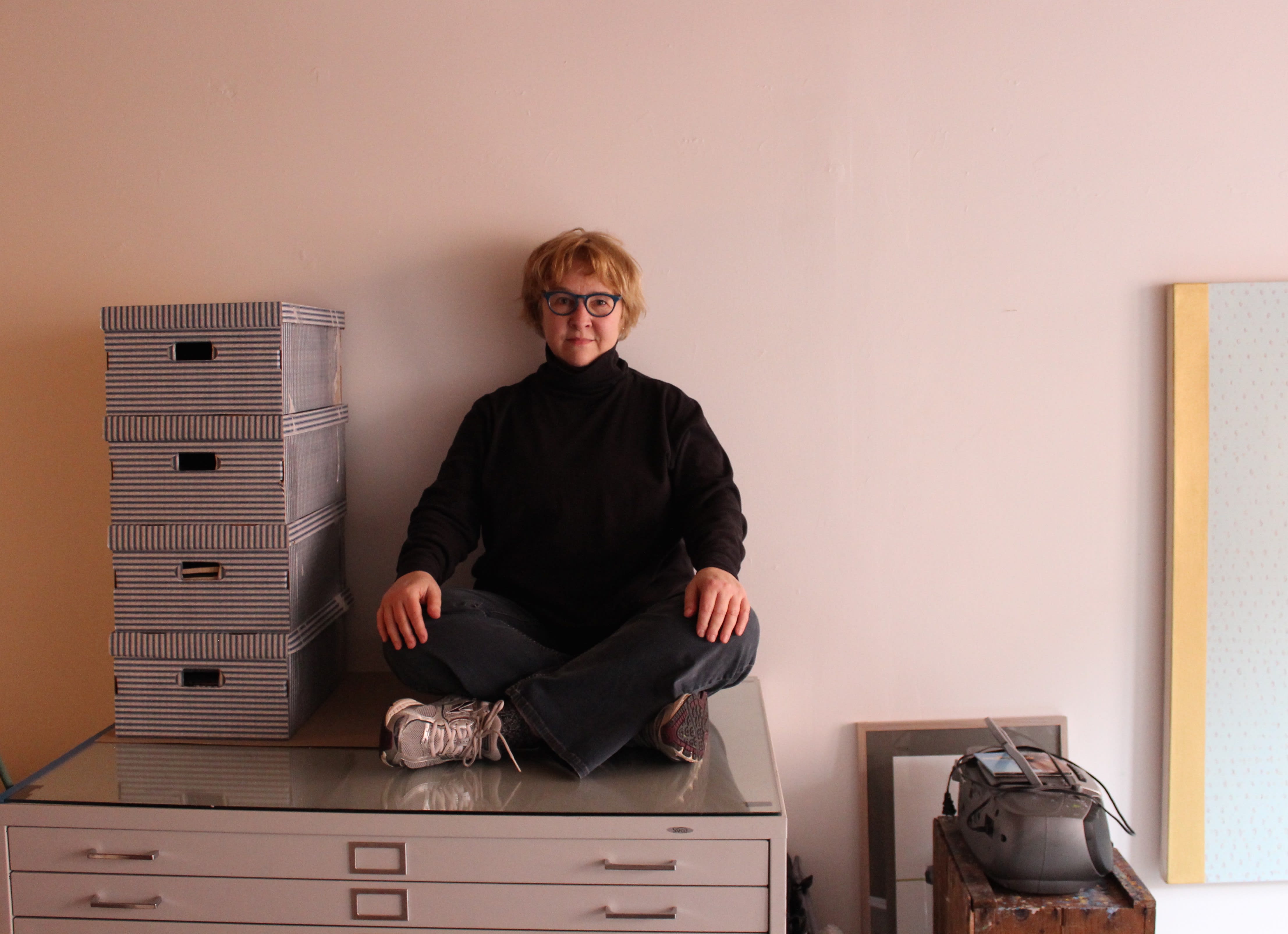
Photo courtesy of the artist
What are your earliest memories relating to art?
As long as I can remember I was a mark maker. I drew on everything, even elaborately in the dirt. As a two year old, I decorated my baby brother's face with my mother's lipstick one morning. Or there was a time when my father was painting pipes in the house and he left an open can of beautiful silver paint in the kitchen. It looked so good that I had to dip the brush in and paint the side of our stove and my sneakers. Later, when I was in first or second grade at a Catholic elementary school, I was very excited about the upcoming May Procession. After school one day, I suggested to my play date that we make our own altar for Mary in our home. We drew a big portrait in crayon on a wall just at the top of the stairs that seemed perfect for an altar. I remember drawing a big picture of her head on the wall, and really focusing on placing the teeth in her mouth. When my mother came up the stairs and saw this, she gasped and I responded, "But Mom, it's the Virgin Mary!" I could go on and on with stories like this. By the fifth grade I could draw better than the nuns so they gave me the job of teaching the art lessons on Fridays.
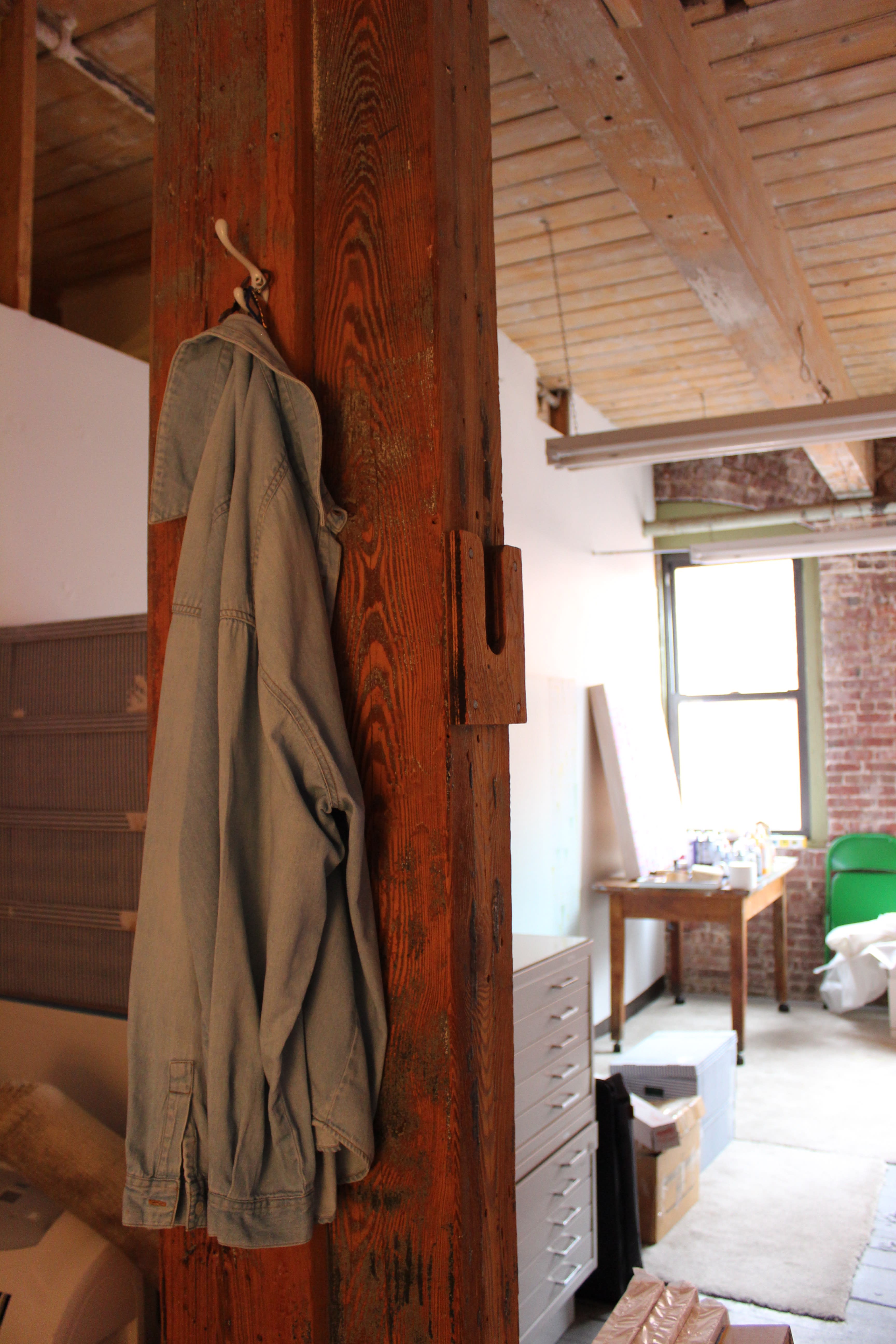
Photo courtesy of the artist
The visual richness of growing up in the Catholic Church with its rituals was definitely something that captured my imagination. It was, for me, a feast for the senses. A reproduction of Grunewald's "Isenheim Altarpiece" was in one of my religious books and I looked at it so often. Unlike many other images, it was so real to me, the depiction of the suffering inherent in the crucifixion.
Essentially, I loved images and poured over them in printed material until I had the privilege of going to galleries and museum, which was like magic to me. Even as a kid, drawing and painting seemed to help me make sense of my world.
Could you talk a little bit about your process? Your works appear to be very planned ahead, but is that actually the case?
My current work is actually not very planned out. However, it is informed by what came before it and from the mixed media materials I use in a random fashion. The papers and fabric I collect do often have meaning to me, though, whether they are formal connections or relative to biographical content. Along with including those materials, I use a variety of tools in addition to brushes to apply paint to the surfaces I work on. At this point in time, my process involves paying close attention to what is happening in my work and is also informed by my verbal reflections as I'm working. I keep workbooks where I reflect on the development of each piece and any questions it poses.
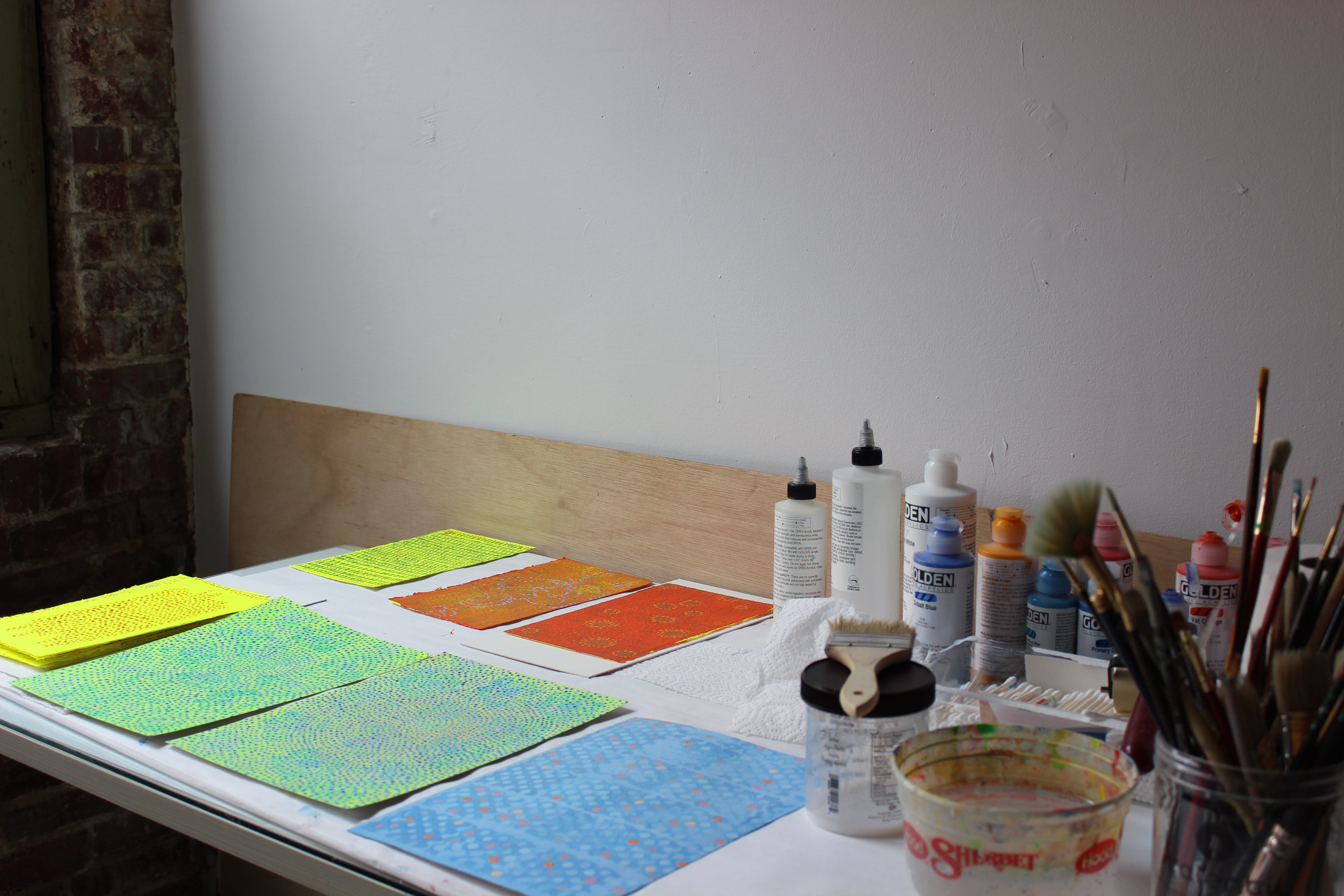
Photo courtesy of the artist
When I go into my studio I know the lay of the land, but I do not know where the work will go within its own geography. I like the mystery of all of that and then, eventually, the acknowledgement of the completed piece. Out of this unknowing a work of art finally comes into reality. The studio, for me, is a very fertile place. When a piece is finished it is almost like it had always existed.
Pattern and geometry is always evident in your work. How does that intersect with the more painterly aspects?
Pattern and repetition is a constant in my work, yes. While there is a kind of geometry, it is flexible, and often skewed. The divisions of the surface are inherently geometric. My interest in this breaking up of the 2D space starts immediately but I often subvert precision with uneven cuts of material or slightly irregular placements. In the past I did use the grid as my underlying structure but as my work became more off-grid, I went with that flow. I love the fluidity of paint and the various viscosities of the material itself. I love how all of those choices and even the amount of pressure I put on the painting tool influences its marking characteristics. Over time I've cultivated more and more sensitivity to all of the many ways these tools can be used to create and bring more of that intuitive element to the work.
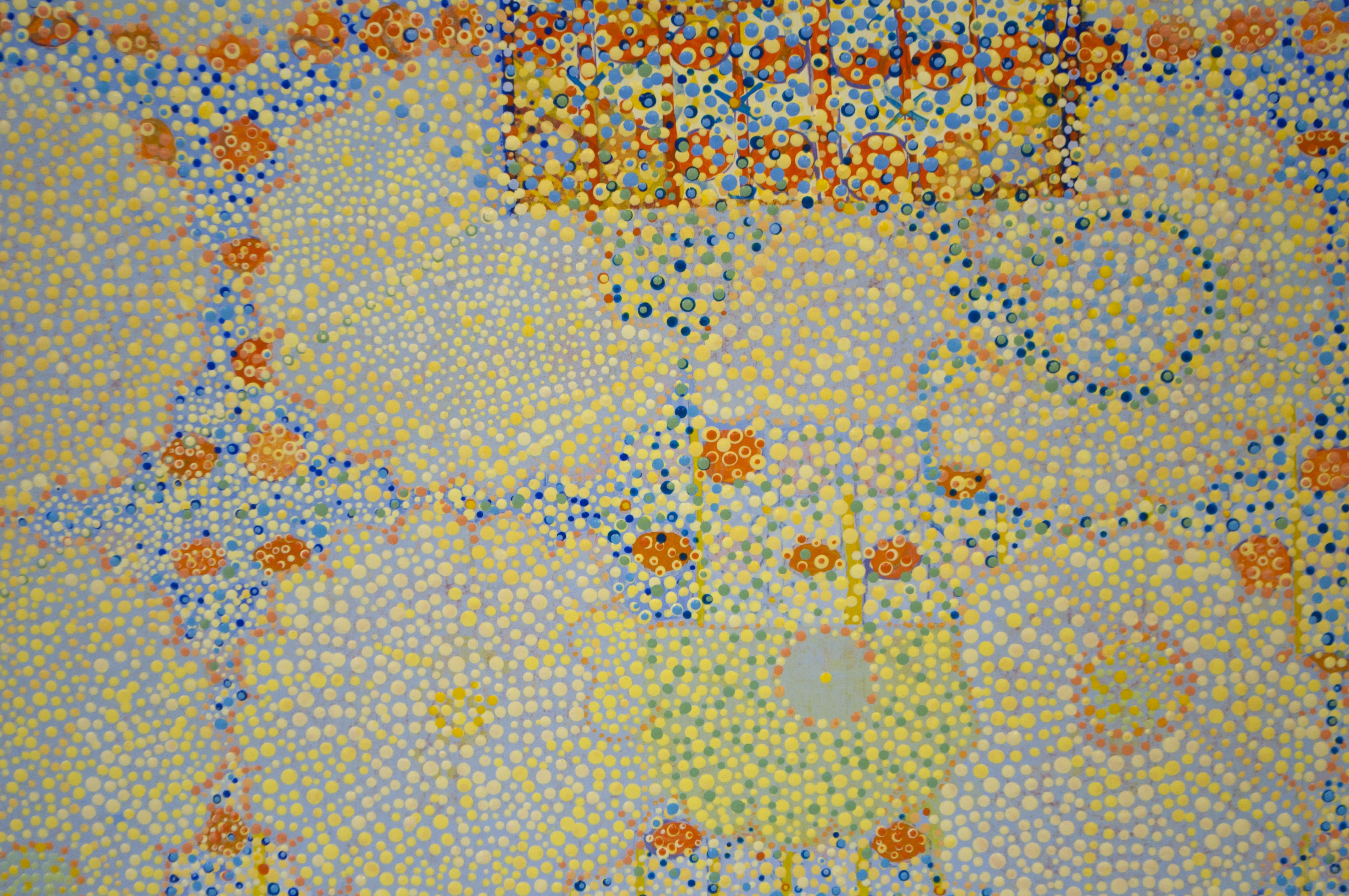
Detail of "Eugene's House," photo courtesy of the artist
A strong sense of color is another characteristic of your work. How did you develop your color sense? How do you decide on your palettes?
Although I have studied color theory, my work with color grows in an intuitive way. The specificity of color combinations is important to me. The simultaneous contrasts make particular vibrations that I pay close attention to while I create my paintings. This paired with the repetition of pattern creates kinds of intervals. When I use collage elements, I respond to the color in those materials to create my palette.
What draws you to working in this pointilist-esque style, where the experience of viewing the work as a whole changes while viewing it up close?
On closer looking one can appreciate the bits of information not noticed in the overall image. Small marks have been evident in my work for a long time now and I continue to explore spatial relationships and color patterns in using small dots, dashes, and blurbs. If I'm using collage materials, those can usually only be revealed when you're up close as well. But I also use large areas of color and collage, which can only really be taken in from standing back from the piece. My work invites others to become slower in their viewing, and that allows for their experiences to meet mine on some level. I am in a kind of meditative zone while I am making my paintings. There's a back and forth while I'm making them. I'll take breaks just to look, and it's in that looking where I figure out what to do next. The looking is also a meditative space for me, but with a different energy.

Detail of "Wild Child," photo courtesy of the artist
You mentioned that workbooks are an important part of your process. How do you use them? What is your relationship with your sketchbooks like?
I utilize them regularly and in many different ways that are specific to my current process. Along with my reflections on my work as I'm creating it, my workbooks are also where I first catalogue all of my completed work, and document communications about my work when it has been exhibited. I'll create free association lists of words or phrases and at times include words with their definitions. They end up being very relative to titling my work. I think this all evolved out of my habit of keeping journals. In graduate school many of us used our sketchbooks to keep our critique notes in order, too. One of my colleagues and I took notes for one another during our group critiques. This proved to be so helpful to me in my studio work that I took notes on my individual studio visits as well. I simply continued with the process after my MFA program and the books evolved over time.

Photo courtesy of the artist
How has your work been evolving lately?
I am just starting to create a new body of work and I plan to use collage in all of it, but we will see. I have been compiling a collection of materials and am in the exciting fresh start phase. I've also noticed the colors are becoming richer but, then again, not always. All is open, and there are so many possibilities ahead.
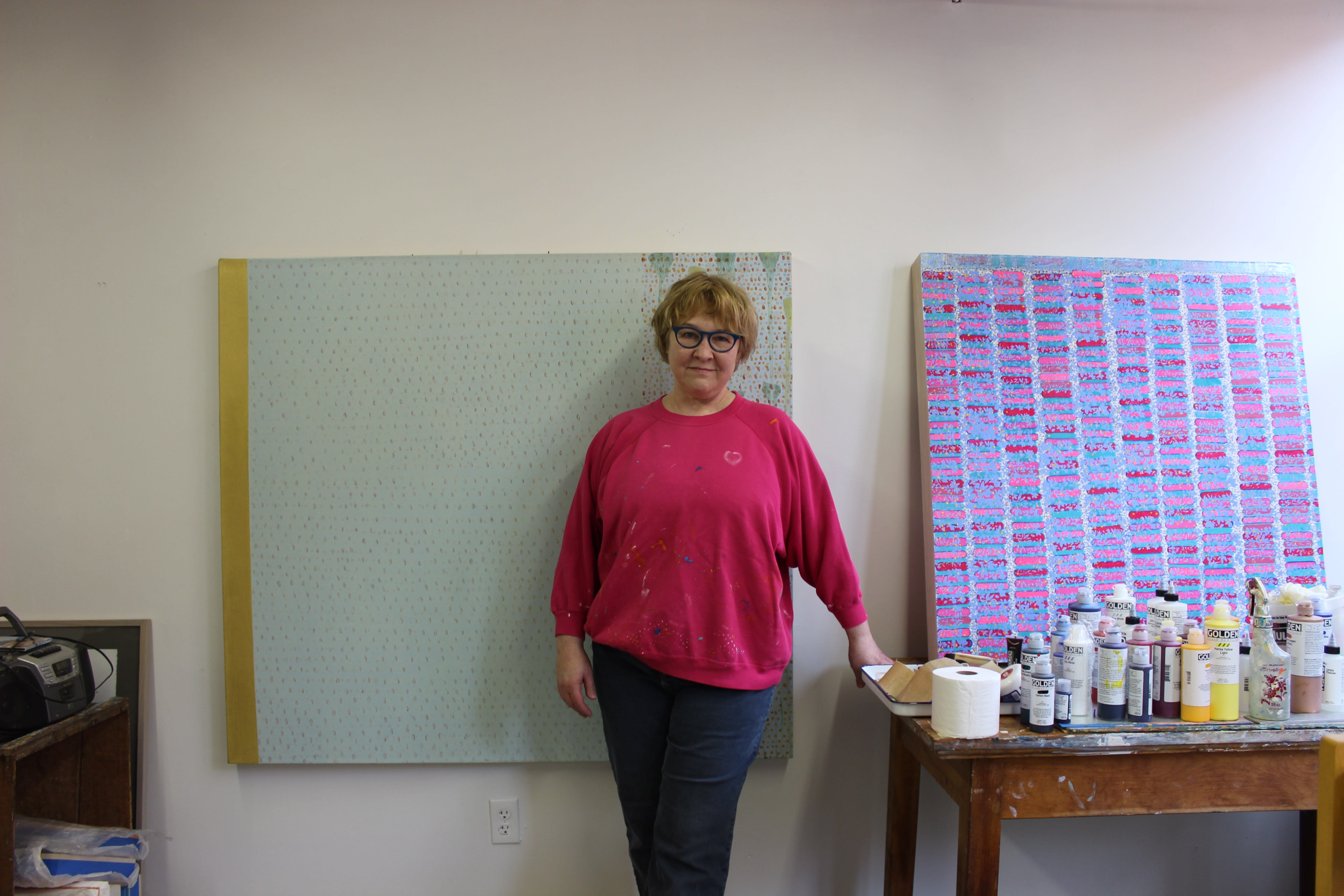
Photo courtesy of the artist
Explore more of Diane Ayott's work here.
Comments
When viewing Diane Ayott's work, it elicits a truly joyful feeling. I have a greater sense of it now, as I perceive the essence of the child's soul, so unchanged within the artist, as it is woven into the flow of her images. It becomes a timeless definition of self. Behind every masterpiece is a story, and to realize the aesthetics of Diane's artistic formulations suffice, but the eloquent read of her memories and descriptions add the dimension of raw excitement, a perfect misinterpretation of the child's motivation. Diane's stories in this exposé have woven new intimate depth to her "pointillist-esque style." For me this is personification through an art form which I am realizing for the first time.
Loved the beginning about childhood memories and writing on walls.
Look forward to seeing more collage work.